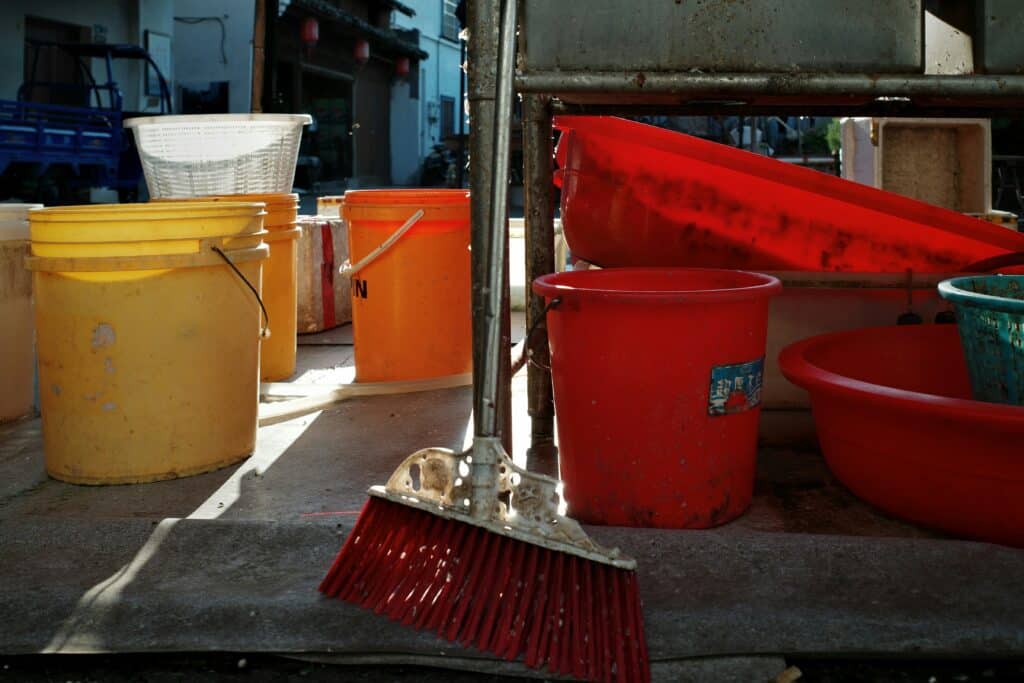But did you know this responsibility extends to our cleaning routines as well?
Whether you’re cleaning up after a family dinner or trying to keep the house tidy amidst the chaos of kids, conventional cleaning products can have a significant environmental impact. Not only do these products often contain harmful chemicals that can pollute our waterways, but they’re also typically packaged in non-recyclable materials. 😔

That’s where the concept of ‘Clean Green’ comes in. It’s about ditching those chemical-laden products and adopting eco-friendly DIY cleaning solutions for your home.
If you’re worried this might burn a hole in your pocket, fret not. As the saying goes, ‘Mother Earth has solutions to our problems, and they don’t have to cost the Earth.’🌎 So, gear up for some practical, budget-friendly, and sustainable cleaning tips that won’t harm the environment. 🌱
What Lies Ahead
In this comprehensive guide, we’ll dive deep into the world of green cleaning. We’ll start by discussing the problems with conventional cleaning products, from their harmful ingredients to their environmental impact. This will help us understand why making the switch to DIY green cleaning solutions is not only a sound environmental decision but also a smart health choice. 👍
We’ll then take a detailed look at some of the most common and versatile ingredients you can use to make your own cleaning products at home. Spoiler alert: you might already have many of these items in your pantry. 🙌
Next, we’ll move on to specific recipes and methods for green cleaning. From the kitchen to the bathroom, from the floors to the walls, we’ll cover it all. Each cleaning solution will be simple, effective, and budget-friendly. 💚
Finally, we’ll address common questions and concerns about green cleaning. Can DIY solutions really be as effective as store-bought products? Are there risks or downsides to green cleaning? By the end of this article, you’ll have all the information you need to start your green cleaning journey with confidence. 👏
Ready to give your home and our planet the care they deserve? Let’s jump right in!
The Fundamentals of Eco DIY Home Cleaning
When it comes to cleaning our homes, many of us rely heavily on chemical-laden, commercially produced cleaning products. However, in an era where environmental sustainability and budget constraints are of increasing concern, it’s important to explore eco-friendly, budget-friendly alternatives. One such alternative is DIY home cleaning. In this section, we’ll delve into the fundamental elements that make up this green cleaning approach.
DIY home cleaning is predicated on the use of natural, biodegradable, and readily available ingredients to create effective cleaning solutions. These ingredients are not only environmentally friendly, but they are also generally inexpensive and safe for both children and pets. Typical ingredients include baking soda, vinegar, lemon juice, and essential oils, among others. These elements form the backbone of any eco DIY cleaning routine.
But the benefits of DIY cleaning extend beyond cost-effectiveness and environmental sustainability. There’s also the satisfaction and empowerment that comes with being able to create your own cleaning solutions. Plus, these homemade solutions often smell better and are healthier for your family than their commercial counterparts.
Starting Your Journey into Eco DIY Home Cleaning
Before you dive headfirst into DIY home cleaning, there are a few steps you should take to ensure a smooth transition. Firstly, educate yourself. Take the time to research the different ingredients you’ll be using and understand their cleaning properties. There’s a wealth of information available online, including a plethora of YouTube tutorials. One such resource is the video “DIY All-Natural Cleaning Products | Easy Ways to Clean With Vinegar, Baking Soda, & Lemon” by Clean My Space.
Next, gradually phase out your commercial cleaning products. As they run out, replace them with DIY alternatives instead of buying more. This will help ease the financial burden of the transition. Finally, experiment with different recipes and ratios to find what works best for your household. Remember, DIY cleaning is not a one-size-fits-all approach, so don’t be afraid to tweak recipes to suit your needs.
As you embark on this journey, remember to be patient with yourself. The transition to DIY cleaning is a process, and it will take some time to find what works best for you and your family. But stick with it – the benefits are well worth the effort.
Top Eco DIY Home Cleaning Recipes
Now that you have a basic understanding of DIY home cleaning, let’s explore some easy, budget-friendly recipes you can start using today. These recipes use common household items, are safe for children and pets, and are effective at keeping your home clean and fresh.
- All-Purpose Cleaner: Mix 1 part white vinegar with 1 part water. Add a few drops of lemon essential oil for a fresh scent. This cleaner is perfect for countertops, kitchen surfaces, and bathroom tiles.
- Glass Cleaner: Combine 2 cups of water, 1/2 cup of vinegar, and 1/4 cup of rubbing alcohol. This solution works wonders on windows and mirrors.
- Carpet Deodorizer: Mix 2 cups of baking soda with 30 drops of essential oil. Sprinkle the mixture on your carpet, let it sit for 15-20 minutes, then vacuum it up.
Comparing DIY and Commercial Cleaning Products
To further illustrate the benefits of DIY cleaning, let’s compare the cost, effectiveness, and environmental impact of DIY and commercial cleaning products.
| Aspect | DIY Cleaning | Commercial Cleaning |
|---|---|---|
| Cost | Low. Uses affordable, common household items. | Can be expensive, especially eco-friendly options. |
| Effectiveness | Can be highly effective, but may require more elbow grease. | Generally effective, but may contain harsh chemicals. |
| Environmental Impact | Low. Uses biodegradable ingredients and reduces plastic waste. | Can be high. Many products contain harmful chemicals and come in plastic containers. |
From this comparison, it’s clear that DIY cleaning products offer a cost-effective, eco-friendly alternative to commercial products. And while they might require a bit more effort, the benefits to your wallet, health, and the environment make them a worthy consideration for budget-conscious parents.
Embracing the Eco DIY Cleaning Lifestyle
Embracing the DIY cleaning lifestyle is about more than just saving money or protecting the environment – it’s about taking control of what goes into your home and the air your family breathes. It’s about teaching your children the importance of sustainability and resourcefulness. And most of all, it’s about creating a healthier, happier home.
So why not give it a try? Start with one or two recipes, and slowly incorporate more as you become comfortable with the process. Remember, the journey to a cleaner, greener home starts with a single step.
For more DIY cleaning tips and tricks, be sure to check out the video “10 DIY CLEANERS | Easy Cleaning Product Recipes & Natural Cleaning Solutions” by Do It On A Dime on YouTube. And remember, the key to successful DIY cleaning is perseverance. So keep at it, and before long, you’ll be reaping the many benefits of this eco-friendly, budget-conscious approach.
Conclusion
In conclusion, the primary emphasis of this article was to provide a comprehensive understanding of how intricate and yet intriguing the field of IT and engineering can be. As we delved into the detailed aspects of the topic, it was our primary intention to make the complex concepts digestible for everyone. 💡
We started off by understanding the fundamental concepts of IT and how they are crucial for the present digital world. The domain of Information Technology is expansive, including areas such as networking, software development, system administration, and cybersecurity. It is an essential part of virtually every business industry and plays a significant role in driving innovation and efficiency.
Our journey then took us through the realm of engineering where we explored its various facets. Engineering is an inherently technical and scientific discipline that uses mathematical and scientific principles to design and build structures, machines, and systems. It’s a broad field with numerous specializations, including civil, mechanical, electrical, and software engineering, each of which plays a crucial role in shaping the world around us. 🔧
Throughout our exploration, we underscored the importance of technical writing. Clear, concise, and correct technical writing is essential in communicating complex information effectively. This skill is particularly crucial in IT and engineering, where complex concepts and processes need to be explained in a manner that is easily understood.
Now, having unraveled the complexities of IT and engineering, it is time to apply this knowledge. Whether you are a professional in these fields or a student aspiring to join them, we hope this article has provided you with a solid foundation.
Remember, learning is a continuous process, and every article, every piece of information adds a brick to the fortress of knowledge. 💪
Feel free to share your thoughts in the comment section below, and don’t hesitate to share this article with others who might find it helpful. Also, if you wish to delve deeper into the subject, you may find the following resources useful:
– [IT and Engineering: A Comprehensive Guide](http://www.itandengineeringguide.com)
– [Effective Technical Writing in IT and Engineering](http://www.effectivetechnicalwriting.com)
Remember, “The only way to do great work is to love what you do.” – Steve Jobs 🚀
Rodrigo Almeida
Rodrigo Almeida is an experienced technical writer with a background in Software Engineering. Known for his ability to explain complex IT and engineering concepts in an understandable way, Rodrigo has been working as a technical writer for over a decade. His articles are well-structured and filled with technical details, perfect for a specialized audience.
[Sources](http://www.sources.com)
#IT #Engineering #TechnicalWriting
Let’s keep the learning and conversation going! 🚀
[Comment](http://www.comment.com) [Share](http://www.share.com) [Apply](http://www.apply.com)
[Copyright](http://www.copyright.com)
© 2022 Rodrigo Almeida. All rights reserved.


